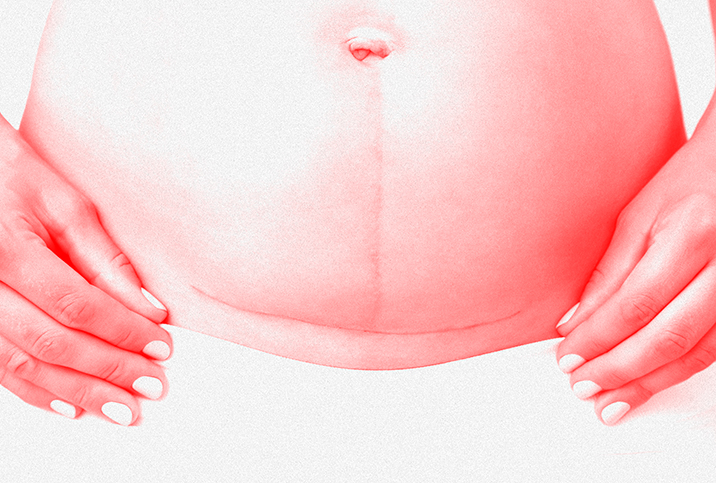Recovering From a Vaginal Birth Can Take Longer Than You'd Think

In the United States, it's typical to have one appointment with your gynecologist six weeks after delivering a baby. And for many people who give birth, that's the only doctor appointment they'll have to check on their own healing.
But at six weeks, roughly a third of people who gave birth with a vaginal delivery are still feeling pain, said Dee Fenner, M.D., chair of the University of Michigan's obstetrics and gynecology department.
"The idea that after six weeks everything is back to normal and happy is really a myth that we tell women," Fenner said, adding that most likely people will need another month to recover, and that after 8 to 10 weeks, 85 percent to 90 percent of people should feel better.
By six months after delivery, about 10 percent of women may still have symptoms like pain, discomfort and incontinence, and they may need some extra help. "All of the recovery that's going to happen will happen by six months. That's an important landmark," Fenner said. At that point, if people are still having issues, Fenner recommends seeing a specialist in postpartum recovery, which may lead to physical therapy or possibly surgery.
Many factors influence recovery time for a vaginal birth, said Aparna Sridhar, M.D., associate clinical professor at UCLA Health. More severe perineal tearing, and the greater number of stitches a person has had to close perineal tears, may lead to a longer recovery. The amount of support a woman has at home may also influence recovery time, along with postpartum issues like lactation problems, pelvic floor dysfunction, hemorrhoids and constipation.
Mood disorders, such as postpartum depression and anxiety, can greatly hamper recovery after delivery. Depression and anxiety can make physical pain worse, and physical pain can increase depression and anxiety, Sridhar said. Anxiety and depression can also affect sleep and the ability to take care of yourself, making recovery more difficult. Lack of sleep alone can hamper recovery and keep the body from relaxing and healing.
And this is all for typical births—that is, vaginal births without significant injuries. For more complex births with more severe injuries, like severe perineal tears, the recovery process can take even longer.
'Ideal recoveries are only for hypothetical people,' Sridhar said. 'Typical recovery is for everybody else.'
Perineal tears are divided into four categories. First-degree tears are in the skin and tissue directly beneath the skin between the vaginal opening and the rectum. Second-degree tears go into the muscle. The most common tears are first- and second-degree tears.
The risk of a tear is higher when the baby is large—say, over 9 pounds; if the baby is looking up instead of down during delivery; if the delivery is a person's first; and if someone pushes actively for more than three hours, Fenner said. The risk of tearing can also increase if delivery is very fast.
Third- and fourth-degree tears are significant birth injuries that extend into the muscle surrounding the vagina and anal sphincter. These severe tears often require months to heal, along with physical therapy, said Jen Hall of MASIC, a foundation in the U.K. that supports women with serious injuries from childbirth. She recommends three months of healing for third- and fourth-degree tears, and then three to six months of physical therapy—so a person with these injuries may be looking at six to nine months of recovery.
For an athlete who experiences a severe muscle tear, months of recovery and physical therapy is normal and often expected. But many people don't assume that kind of recovery with birth injuries. "Because it's still a vaginal delivery—it's not an emergency C-section—it's very easy for health professionals to label it a 'normal' birth," Hall said.
These more complex vaginal births occur more often when instruments are used, like forceps. MASIC campaigns for informed consent in pregnancy so women know the risks they are facing with a vaginal delivery, and they are given that information honestly as they are with C-sections.
"Women are told about the risks of C-section delivery when they are pregnant, and they're quite actively persuaded to have a vaginal delivery. But they're not told of the risks when a vaginal delivery isn't straightforward and instruments might have to be used," Hall said.
Everyone's delivery is different, and no person has perfection in every factor that influences recovery. And yet the six-week appointment after delivery is routine in the U.S. no matter what the delivery is like.
Fenner said the six-week appointment likely came from the desire to get women back on birth control before they ovulated again—making the appointment much more about contraception than recovery. But the appointment is often the only one that a woman will have with her gynecologist after delivery, and that six-week time period is often all that an insurance company will cover under short-term disability.
Slowly, the idea of the six-week recovery timeline is changing in the U.S. The American College of Obstetricians and Gynecologists now recommends the timing of postpartum visits be individualized. It recommends an initial assessment—which can be virtual—within the first three weeks after delivery, and then if all goes well, a follow-up no later than 12 weeks after delivery, with ongoing care as needed.
Most people will be healed before those 12 weeks are up—twice as long as the perhaps unrealistic ideal of a full recovery at six weeks. "Ideal recoveries are only for hypothetical people," Sridhar said. "Typical recovery is for everybody else."

















